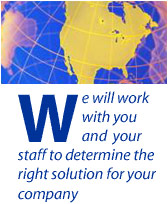
 |
Audio and Video Conferencing Conferencing services can help save time and money for companies that need to communicate externally with groups of people. Business travel is costly, and many people are concerned about their personal security and health when traveling. Conferencing services can alleviate these concerns, help with employee productivity, and facilitate faster business decisions. Audio conferencing Audio conferencing is the most cost-effective means of conferencing because it can be done with standard phone equipment or speaker phones. There are different ways an audio conference call can be set up:
Video conferencing Video conferencing requires equipment utilizing monitors and cameras to facilitate the meeting and therefore can be costly, depending on the level of quality. A video conference session is more personalized then audio conferencing because you can see the person’s expressions and gestures on the other end. There are 2 basic categories of video conferencing, point to point and multi-point. Point to point involves 2 sites communicating back and forth. Multi-point involves 3 or more sites communicating. The most basic, inexpensive form of video conferencing is conducted over a desk top. More sophisticated desk top video conferencing can incorporate shared computer images, such as a power- point or an excel spreadsheet. This can be beneficial in training or technical applications. When larger groups need to conference or better quality is needed, typically specialized video equipment is used. This type of application employs different types of connectivity. The most common is ISDN or Integrated Services Digital Network. ISDN is available in 128K, 384K, 512K, to full T1. The Internet can also be used for Video Conferencing. Video Conferencing is complex. There are many questions to consider in selecting the right solution. Here are a few basic questions:
Telecom Source Group will be your company’s
advocate by helping you to sort through the complexities of the
different carriers’ offerings and solutions. We will help
you find the video conferencing solution that will best meet the
needs of your company. |
|||||||